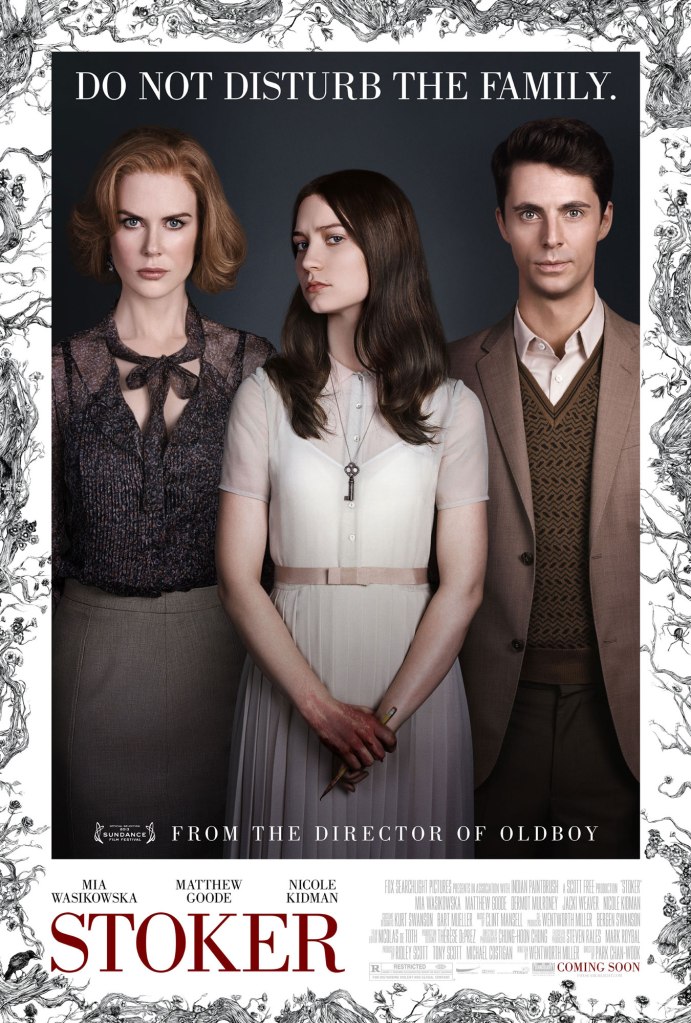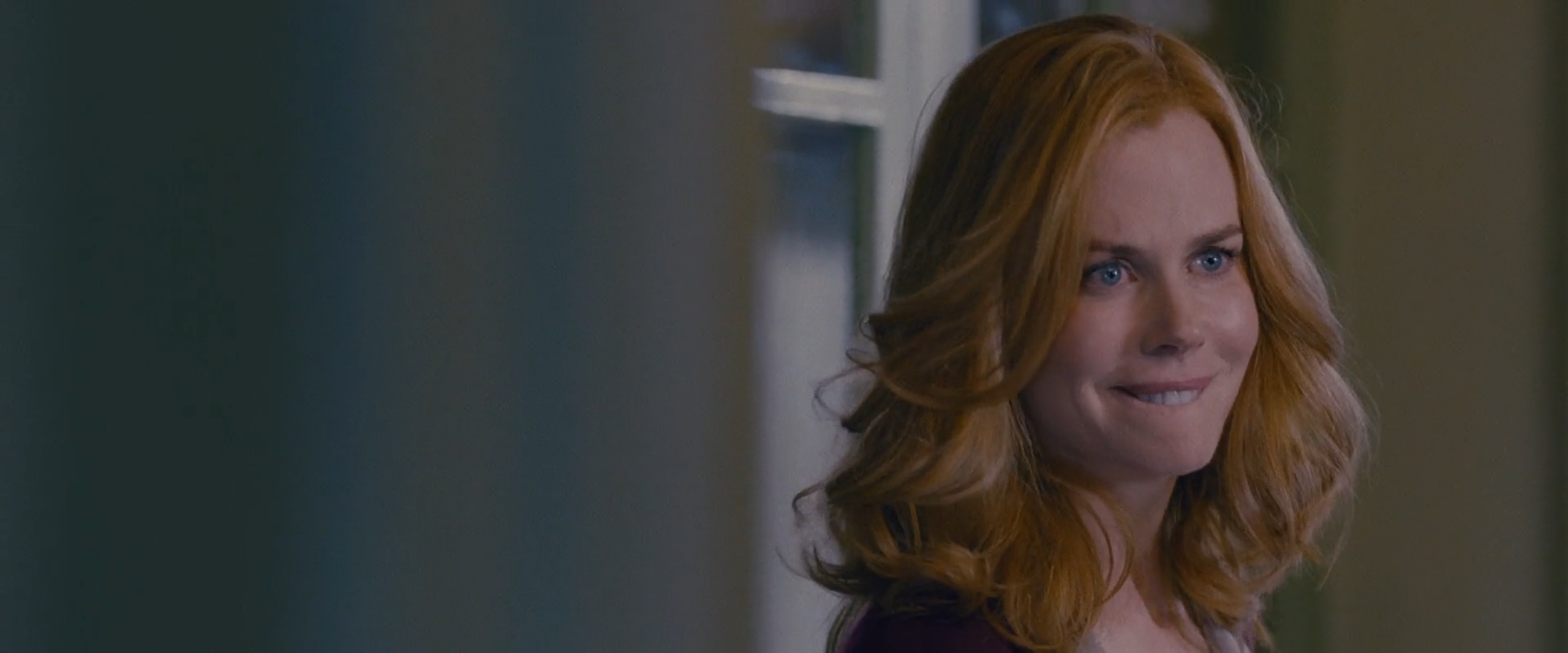
This review originally appeared as a guest post on 10 Years Ago: Films in Retrospective, a film site in which editor Marcus Gorman and various contributors revisit a movie on the week of its tenth anniversary. This retro review will be a bit more free-form, recappy, and profanity-laden than usual.
CW: Sexual assault
“You know, I’ve often wondered why it is we have children in the first place. And the conclusion I’ve come to is… At some point in our lives we realize things are screwed up beyond repair. So we decide to start again. Wipe the slate clean. Start fresh. And then we have children. Little carbon copies we can turn to and say, ‘You will do what I could not. You will succeed where I have failed.’ Because we want someone to get it right this time. But not me… Personally speaking I can’t wait to watch life tear you apart.”
-Evelyn Stoker (Nicole Kidman)
Evie’s “fuck you, child o’ mine” speech, delivered directly to the face of her daughter India (Mia Wasikowska), happens near the end of Stoker, and thanks to both Kidman’s chilling delivery and its prominent placement in the film’s trailer, it is one of the only things I remembered about this Park Chan-wook film, written by Prison Break star Wentworth Miller and punched up by playwright Erin Cressida Wilson, whom I primarily knew from her work on the 2009 erotic drama Chloe. I’m a little more selective with my 10YA selections these days, trying to revisit movies because I expect I’ll have something new to say about them. Now that I’ve been a parent for most of the last decade, I thought this could be an interesting exercise in pondering how far gone a parent-child relationship would have to be for me to say something like this.
I suppose I could’ve gone with India’s opening monologue instead, but her insistence that she can hear what others don’t hear, and see what others don’t see, plays initially like the mere self-importance of youth, and not a literal, plot-critical heightening of the senses. With the minor exception of her Aunt Gin (brief appearance by Jacki Weaver), India is the first to understand the precise danger surrounding her uncle Charlie (Matthew Goode), who appears in her life for the first time upon the tragic, car-crash death of her father Richard (Dermot Mulroney). Charlie spins a tale of adventure and world travel that explains his long absence from the family (this is the first time Evie has met him as well). But by the time her realization occurs, India has already developed an odd, incestuous connection with him, so her knowledge doesn’t matter in the way it perhaps ought to. I won’t be shy about spoiling the ways in which creepy Uncle Charlie isn’t exactly what he seems, so consider this an additional warning. But let’s talk about The Family for a minute. The Stokers are wealthy – they live in a mansion and dress with stolid, old-fashioned formality, including India’s annual parental gift of saddle shoes to emphasize her child-like innocence (the film contains a number of unsubtle visual nods to this point). Their manner, as well as the title and marketing of the film, seem deliberately intended to evoke vampirism – but the Stokers don’t need to be vampires to just seem kinda generically creepy. Evelyn is perhaps the most ordinary among them, a kept woman who feels distant from her daughter and rarely leaves the house, but brags about her formal education – she can speak fluent French despite never having occasion to use it (Je ressens ta douleur, Evie). The flashbacks (in which India and Richard go on an assortment of hunting trips together), seem to suggest a Dexter-like psychopathy shared between the two – a need to be a murderous predator that Richard sought to help her channel into safer avenues than becoming a serial killer. That is also kept pretty vague (since Richard is dead and we barely hear them discuss it), but that’s about as much of an explanation as we ever get for India’s sudden, sympathetic turn toward her creepy uncle, whose greatest service to her up to that point was choking out her would-be rapist Whip Taylor (played, with frustrating charisma, by Alden Ehrenreich) while he was literally on top of her – a scene that she would dramatically relive while washing Whip’s blood off in the shower, first weeping and then masturbating about it.

The attempted rape feels perfunctory, given that Whip is basically a non-entity prior to this moment (he’s one of several teenage dirtbags she wanders past without speaking to), but it points to Stoker‘s lurid fascination with the loss of virginal innocence. The film is rife with imagery of pure, white clothing becoming dingy or blood-soaked, and the aforementioned shower scene begins with India removing her childlike shoes, which have become stained by her uncle’s actions in the previous scene, even as she’s not quite ready to shrug them off until the end. She glances furtively into the abyss of negative experiences awaiting a girl in this world, and finds the prospect titillating. This could be an interesting – if disturbing – avenue to explore in this film. But…the shower scene is basically it. One chance (among several) for the audience to shallowly ponder that India must’ve had a dark streak prior to this moment: a hint of what’s to come, but also a cheap shock. Stoker also seems to have as little interest in clarifying the family’s vampiric and incestuous creepitude as it does in understanding why Uncle Charlie spent his 20+ years in a mental institution – after murdering his younger brother as a child – writing letters to India from the moment she was born. In his letters, Charlie plays at establishing a familial relationship with this person he’s never met, confabulating globetrotting adventures that are keeping him away from her, and endowing her as his partner in crime, whom he loves dearly. An immature mind might feel flattered. A worldly mind would see that the letters have nothing to do with India herself, so much as the idea that Charlie has built around her. Richard Stoker wisely kept the letters hidden from his daughter – we can only guess what he planned to do with them once she was old enough to comprehend her uncle’s danger and depravity – but this is perhaps what makes their revelation feel so hollow. As India peruses each letter, covered with elegant calligraphy and hand-drawn illustrations, she spends a bare moment lamenting the relationship she might have had with her uncle, then realizes (via an address stamp on the back) that the letters – and that relationship – are pure fiction. The family’s vague sense of danger goes herky-jerky for a moment, but ultimately stays vague.
Why did Charlie kill his brother as a child? Because he’s evil, I guess. Why was he romantically obsessed with a baby, like so much Jacob Black from Twilight? Because he’s evil and hypothetically pervy, I guess. And why does India decide to ditch her spacey mother and join his folie à deux, about two screen-minutes before shooting him dead with a hunting rifle? Maybe he was evil but underestimated how evil she was? Maybe the next generation is always a little bit better? Or maybe her childhood not spent in a psychiatric hospital gave her the opportunity to become a bit better at killing before the moment presented itself. Charlie might not hesitate in that moment, but he kinda peaked early with his murder-by-sandcastle – his remaining murder skills are acts of rudimentary barbarism: smacking people with rocks, and choking them them out with belts, etc. The mere vibe of Stoker is perhaps enough to carry its audience through (we did give it a 7.5/10 on the podcast at the time), but it all just feels a little bit quaint to me now. Its depiction of the surrounding town – which at its best, evokes the kind of teenage layabout antics seen in Stand by Me or Donnie Darko – albeit with a much less important supporting cast – feels perfunctory and standoffish. And while the film’s performance of uncomfortable romantic obsession is mildly interesting, Park has frankly done this better twice since (in both The Handmaiden and Decision to Leave (the latter was my #3 of last year).

In addition to becoming a parent in the past decade, I’ve perhaps become a bit less comfortable with a film presenting a set of characters as creepy or evil without even pretending to offer a reason why. I don’t need every movie to be an origin story, but I would like some mildly coherent explanation for why people are the way they are, even if it only exists in subtext. Otherwise, we can just slap the “psychological thriller” label on it and not bother to interrogate that designation, because “I dunno, he’s just crazy” is all we can be bothered to come up with. Uncomplicated evil can be interesting to watch, but…this ain’t it for me anymore. What we have instead is India, which the film treats as a sort of tableau – painted with the beliefs, biases, blind spots, and behaviors of her parents and experiences, but also tarred with the brush of original sin. India announces at the outset that in the same way a flower does not choose its color, we are not responsible for what we have come to be. And she is vaguely aware that as an adult, she can make more lasting choices about her fundamental nature. We see her make just such a choice as she waylays and murders her local sheriff – a final loose end in the trail of bodies she and Charlie have left behind. But in the end, Evie’s fuck-you speech is less about anything India is or does, and more about her own disappointment with her life and choices. Just like Charlie’s letters, she’s spinning a yarn that has little to do with its real-life subject. As I look at my own children, the idea of wanting life to rip them apart feels aberrant to me. But the fear of that very thing happening to them feels part and parcel with being a parent in this world – as it is, and always has been. Previous generations may not have had climate change to deal with, but they did have war and plague. And they carried on – at least the ones that survived. Watching this scene again, with intense anger and sadness in Kidman’s eyes, and curious, predatory nihilism in Wasikowska’s, I felt a deep swell of pity for Evie. This speech is not only the most memorable and specific component of Stoker, but it is definitely what makes Kidman’s performance the standout. Goode and Wasikowska acquit themselves well, but I have a much harder time describing what they were actually doing here.
FilmWonk rating: 5 out of 10










